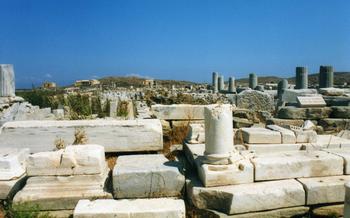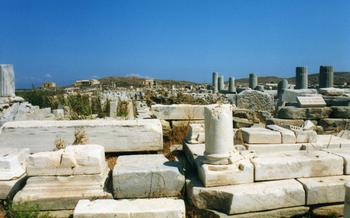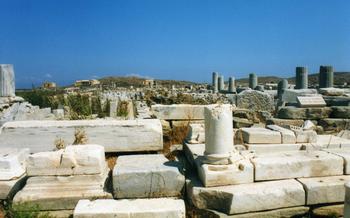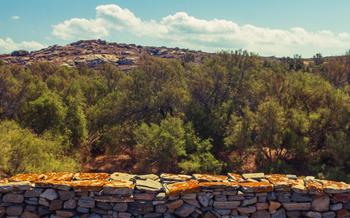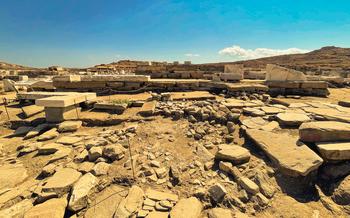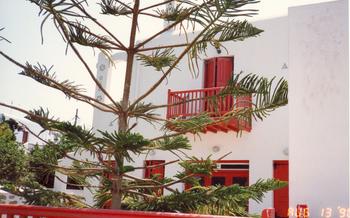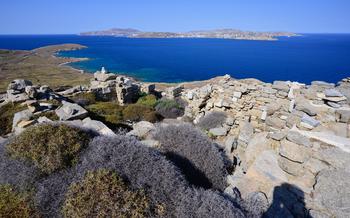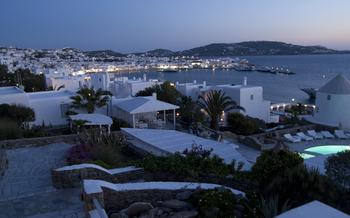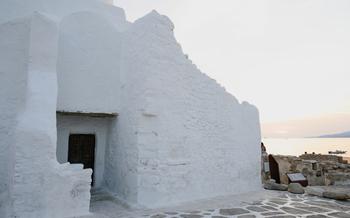
Theatre of Delos
- Historical Significance:
- Getting There:
- Entrance Fees and Opening Hours:
- What to See
- Photography Tips:
- Delos Archaeological Museum
- Guided Tours
- Plan Your Visit
- Things to Do Nearby
- Where to Eat and Drink
- Where to Stay
- Best Time to Visit
- Accessibility:
- Insider Tip: Explore the Hidden Gem of Rhenia
Historical Significance:
Explore the ancient city of Delos, a UNESCO World Heritage site, and step back in time to discover its rich history. Delos was once a thriving religious and commercial center, and its ruins offer a glimpse into the grandeur of the ancient Greek civilization. Wander through the remains of temples, houses, and other structures, and admire the well-preserved mosaics and frescoes that adorn their walls. At the nearby Archaeological Museum of Mykonos, you can see artifacts from Delos, including sculptures, pottery, and jewelry, which provide further insights into the daily life and culture of this ancient city.
Getting There:
To reach Delos from Mykonos, you can take a ferry from the port of Mykonos Town. Ferries depart several times a day, and the journey takes around 30 minutes. It is advisable to check the ferry schedule and book your tickets in advance, especially during the peak tourist season (July-August) when demand is high and tickets can sell out quickly.
Once you arrive at Delos, you will need to walk for about 15 minutes from the ferry dock to the ancient site. The path is well-marked, but it can be a bit rough and uneven, so it is important to wear comfortable shoes. Alternatively, you can take a taxi or a horse-drawn carriage from the dock to the site for a small fee.
Entrance Fees and Opening Hours:
Before embarking on your journey to Delos, it is essential to be aware of the entrance fees and opening hours to ensure a smooth and hassle-free visit. The official website of the Hellenic Ministry of Culture and Sports provides up-to-date information on current fees and hours. Typically, the entrance fee includes admission to both the archaeological site of Delos and the Archaeological Museum of Mykonos. Fees may vary depending on the time of year, so it is advisable to check the website before your trip.
Opening hours are subject to seasonal changes. During the summer months (April to October), the site is generally open from 8:00 AM to 8:00 PM, allowing ample time to explore the ruins and soak in the ancient atmosphere. In the winter months (November to March), hours may be shorter, typically from 8:30 AM to 3:00 PM. It is always recommended to arrive early to avoid crowds and make the most of your visit.
Guided tours are available for an additional fee and offer a deeper understanding of the site's history and significance. These tours are conducted by knowledgeable guides who can provide insights into the lives and culture of the ancient inhabitants of Delos. Guided tours are available in various languages, making it accessible to visitors from different parts of the world.
What to See
At the heart of Delos lies the well-preserved ruins of the Theatre of Delos, a testament to the island's vibrant cultural past. Built in the 3rd century BC, this impressive structure could accommodate up to 5,500 spectators. As you step into the theater, let your imagination transport you back in time, envisioning the grand performances that once took place here.
Admire the remarkably preserved stage building, featuring intricate carvings and sculptures that have stood the test of time. Imagine the actors and musicians gracing this stage, captivating the ancient audience with their performances. Take your time to explore the seating area, where rows of marble seats rise in tiers, offering a breathtaking view of the stage and the surrounding landscape.
Beyond the theater, Delos is adorned with a wealth of other ancient ruins that await your exploration. Discover the Temple of Apollo, a majestic structure dedicated to the patron deity of the island. Stroll through the House of Dionysus, a lavish private residence adorned with stunning mosaics and frescoes depicting scenes from Greek mythology. Each corner of Delos holds a story, waiting to be uncovered as you wander through this archaeological wonderland.
Photography Tips:
When visiting Delos, don't forget to bring your camera to capture the stunning views and ancient ruins. A wide-angle lens will allow you to fit everything into your shots, while taking advantage of the natural light will give you the best results. Experiment with different angles and perspectives to create unique images that will remind you of your visit for years to come.
Delos Archaeological Museum
After exploring the ancient ruins of Delos, make sure to visit the Delos Archaeological Museum, which houses a wealth of artifacts discovered on the island. The museum's collection includes sculptures, pottery, jewelry, and other objects that provide a glimpse into the daily lives and culture of the ancient Delians.
One of the highlights of the museum is the collection of sculptures, which includes statues of gods and goddesses, as well as everyday people. The museum also has a large collection of pottery, including both utilitarian and decorative pieces. The jewelry collection includes a variety of gold and silver pieces, as well as semi-precious stones.
The Delos Archaeological Museum is a great place to learn more about the history and culture of the ancient city. The museum is well-organized and informative, and the exhibits are presented in a way that is accessible to visitors of all ages. The museum is also a great place to cool off on a hot day, as it is air-conditioned and has a café.
Guided Tours
If you want to learn more about the history and significance of Delos, consider booking a guided tour. Tours are available in different languages and typically last for about 2 hours. Guides can provide insights into the ancient city's history, culture, and architecture. They can also point out interesting features that you might miss on your own.
Guided tours are a great option for those who want to make the most of their visit to Delos. They are also a good choice for families with children, as guides can keep the kids engaged and entertained.
To book a guided tour, you can contact the Mykonos Tourist Information Office or one of the many tour operators on the island. You can also book a tour online in advance.
Here are some tips for choosing a guided tour of Delos:
- Make sure the tour is led by a licensed and experienced guide.
- Choose a tour that fits your interests and budget.
- Book your tour in advance, especially during peak season.
- Wear comfortable shoes and clothing, as there is a lot of walking involved.
- Bring water and sunscreen, as there is no shade on the island.
Plan Your Visit
To fully appreciate the wonders of Delos, it is advisable to allocate at least 2-3 hours for your exploration. The ancient city is vast, with numerous ruins and artifacts to discover. Comfortable footwear is essential, as the site involves a significant amount of walking on uneven terrain.
To protect yourself from the intense Greek sun, remember to bring a hat, sunscreen, and sunglasses. It is also advisable to carry a bottle of water and some snacks, as there are no food and beverage options available on the island. Proper planning will ensure a comfortable and enjoyable visit to this captivating historical site.
Things to Do Nearby
Delos is just one of the many incredible destinations in the Mykonos area. Once you've explored the ancient ruins, take some time to venture out and see what else the island has to offer.
-
Rhenia Island: Just a short boat ride from Delos, Rhenia is a small, uninhabited island with a beautiful sandy beach and crystal-clear waters. It's the perfect place to relax and swim after a day of exploring ancient ruins.
-
Mykonos Town: The main town of Mykonos is a charming maze of whitewashed buildings, narrow streets, and lively shops and restaurants. Take some time to wander through the town, soak up the atmosphere, and do some shopping.
-
Boat Tours: There are many boat tours available from Mykonos that will take you to the surrounding islands and coves. This is a great way to see the stunning scenery of the Mykonos archipelago and to visit some of the smaller, less-visited islands.
-
Nightlife: Mykonos is known for its vibrant nightlife, with many bars and clubs to choose from. Whether you're looking for a relaxed night out or a wild party, you're sure to find something to your taste.
Where to Eat and Drink
After a fascinating exploration of Delos, indulge in the culinary delights of Mykonos Town. The town offers a diverse range of restaurants, catering to every palate and budget. Savor traditional Greek dishes such as moussaka, a flavorful eggplant and minced meat casserole, or souvlaki, succulent grilled meat skewers. Gyros, a popular street food, is a must-try, featuring pita bread filled with grilled meat, vegetables, and tzatziki sauce.
Pair your meal with a glass of local wine from the vineyards of Mykonos. Sample the crisp and refreshing white wines or the robust and fruity red wines. Ouzo, a traditional Greek anise-flavored spirit, is a popular choice, often enjoyed with meze, a selection of small dishes. Raki, a grape-based spirit similar to brandy, is another local favorite.
For a unique dining experience, find a rooftop bar or terrace that offers panoramic views of the town and the Aegean Sea. Sip on cocktails or local drinks while enjoying the sunset over the picturesque harbor.
Where to Stay
Mykonos offers a wide range of accommodation options to suit all budgets and preferences. Whether you're looking for a luxurious hotel, a charming apartment, or a budget-friendly hostel, you'll find something to meet your needs.
If you want to be close to the action, consider staying in Mykonos Town. This vibrant area is home to many restaurants, bars, and shops, as well as the island's main port. You'll also be within walking distance of the iconic windmills and the Little Venice district.
For a more relaxed stay, consider one of the quieter villages on the island, such as Ano Mera or Tourlos. These villages offer a more traditional Greek experience, with whitewashed houses, narrow streets, and tavernas serving delicious local cuisine.
No matter where you choose to stay, be sure to book your accommodation in advance, especially if you're traveling during the peak season. Mykonos is a popular destination, and prices can be high, particularly in July and August.
Here are a few tips for finding the best accommodation in Mykonos:
- Do your research. There are many different websites and travel agencies that can help you find the perfect place to stay. Read reviews and compare prices before you book.
- Consider your budget. Mykonos can be an expensive destination, so it's important to set a budget before you start looking for accommodation. There are options to suit all budgets, from hostels and guesthouses to luxury hotels.
- Think about your location. If you want to be close to the nightlife and restaurants, consider staying in Mykonos Town. For a more relaxed stay, choose one of the quieter villages on the island.
- Book early. Mykonos is a popular destination, so it's important to book your accommodation in advance, especially if you're traveling during the peak season.
Best Time to Visit
The best time to visit Delos is during the shoulder seasons (May-June and September-October). During these months, the weather is still warm and sunny, but there are fewer crowds. This makes for a more enjoyable experience, as you can explore the ancient site without feeling rushed or overwhelmed.
Avoid visiting Delos during the peak summer months (July-August), when temperatures can be high and crowds are at their peak. The heat can make it difficult to walk around the site, and the crowds can make it difficult to appreciate the ruins.
If you are visiting Mykonos during the peak season, it is still possible to visit Delos, but it is important to plan your visit carefully. Try to arrive early in the morning or late in the afternoon, when the crowds are smaller. You should also book your ferry tickets and guided tour in advance, to avoid disappointment.
Accessibility:
Delos is not wheelchair accessible due to the uneven terrain and lack of ramps. Strollers are also not recommended, as there are many steps and narrow paths. Visitors with mobility issues should consider taking a guided tour, which can provide assistance.
The ancient city of Delos is a UNESCO World Heritage site, but accessibility for visitors with disabilities is limited. The uneven terrain and lack of ramps make it difficult for wheelchair users and those with mobility impairments to navigate the site independently. Strollers are also not recommended due to the many steps and narrow paths.
For visitors with mobility issues, the best way to experience Delos is to take a guided tour. Guided tours can provide assistance with navigation and offer insights into the history and significance of the site. Visitors should contact tour operators in advance to inquire about accessibility options and to make arrangements for assistance.
In addition to the physical challenges, visitors with disabilities may also encounter communication barriers. Signage and information materials may not be available in accessible formats, and tour guides may not be trained in disability awareness. Visitors with disabilities are encouraged to bring a companion or advocate to assist them with communication and other needs.
Despite the challenges, Delos is a fascinating and rewarding destination for visitors of all abilities. With careful planning and assistance, visitors with disabilities can enjoy a memorable and enriching experience exploring the ancient ruins and learning about the history and culture of this remarkable island.
Insider Tip: Explore the Hidden Gem of Rhenia
Combine your visit to Delos with a trip to the nearby island of Rhenia for a truly unforgettable experience. Just a short boat ride away from Mykonos, Rhenia is a hidden gem that offers a tranquil escape from the crowds. Step ashore and discover a pristine beach with crystal-clear waters and soft, golden sand. Immerse yourself in the serenity of this secluded paradise, where you can relax, swim, and soak up the sun's warmth.
Rhenia is an ideal destination for those seeking a peaceful retreat. With its unspoiled natural beauty and lack of tourist development, the island exudes an aura of tranquility that is hard to find elsewhere. Take a leisurely stroll along the beach, breathe in the fresh sea air, and let the gentle sound of the waves lull you into a state of relaxation.
To make the most of your time on Rhenia, consider packing a picnic lunch and finding a secluded spot to enjoy it. There are no restaurants or cafes on the island, so bringing your own food and drinks is essential. Remember to bring plenty of water, as there are no sources of fresh water on Rhenia.
For those who enjoy exploring beyond the beach, Rhenia offers a few hidden surprises. Follow the path that leads inland and discover the ruins of an ancient settlement, remnants of a bygone era. Explore the stone foundations of houses, storage rooms, and other structures, and let your imagination transport you back in time.
As the sun begins to set, return to the beach and witness a magical spectacle. The sky transforms into a canvas of vibrant colors, painting the horizon with hues of orange, pink, and purple. Capture this breathtaking moment with your camera or simply sit back and savor the beauty of nature's grand finale.
Whether you seek relaxation, adventure, or a glimpse into the past, Rhenia has something to offer every traveler. Embark on a journey to this enchanting island and create memories that will last a lifetime.
